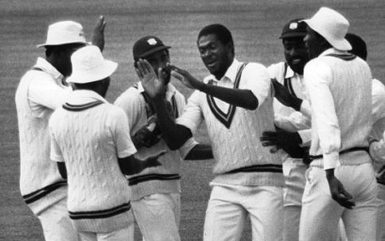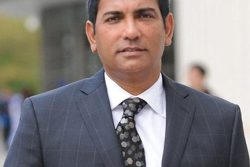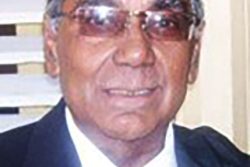In this week’s edition of In Search of West Indies Cricket, Roger Seymour looks for the best West Indies XI to play in a Test Match.
There has been and will always be heated discussions—tempers flaring and friendships tested—among West Indian fans, as to who should be selected in an All-Time West Indies XI. One school of thought is that there are too many variables at play here and it isn’t possible to truly compare players from different eras, for selection to a Team for the Ages.
We can begin by taking a quick glance at some of the more important variables contributing to this dilemma.
Travel
The 1930 West Indies side travelled from island to island and BG, by banana boat, for the home series versus England and had to endure one month at sea, from Panama, across the Pacific Ocean, for their trip to Australia, for the 1930/31 Tour. The modern-day player enjoys the luxury of jetting from venue to venue.
Equipment and protective gear
Back in the day, players wore heavy high-top boots and batted with cumbersome pads. Today’s footwear is light years ahead of its predecessors. Subsidiary equipment such as pads, batting gloves, bats and helmets (in regular use since 1977/78) is constantly being improved by modern technology.
Wickets
Pitches have only been covered since the 1960s. Before, batsmen were exposed to ‘sticky dogs,’ wet wickets that had been exposed to the sun; the wrist spinners’ perfect dream. Pitches are now grown and ‘dropped-in’ and are covered overnight, and at the slightest hint of rain. The latter has led to more uniform batting conditions around the world.
In 1986, Pakistan’s Captain Imran Khan, tired with the complaints of ‘hometown’ decisions, invited two Indian umpires to stand in the Test Match versus the West Indies at Lahore. In 1992, the ICC began appointing one neutral umpire and a third umpire. The latter, or TV umpire reviewed run outs, stumpings and boundaries only, aided by slow-motion replays on TV. The previous year, the match referee became part of the officiating crew. In 2002, two neutral umpires first appeared in Tests during India’s visit to the West Indies.
Rule changes
Citing the slow over rate produced by fast bowlers (referring to the West Indies in other words), the ICC introduced “the one bouncer per batsman per over” rule in 1991 to end the intimidation. Later, it was amended to two in 1994. This change in the law, shifted the balance significantly away from the West Indies.
Remuneration

Today’s cricketer is a full-time professional, earning excellent compensation and can dedicate all his time to training and practice, whilst enjoying the support of an array of specialists such as doctors, physiotherapists, trainers, nutritionists, fielding coaches, to name a few. Cricketers of bygone eras were poorly compensated for their efforts on the field. They held regular jobs to make ends meet, and often walked away from the game in their prime.
So how can we select the Best Team of all Time? This writer opted to divide WI Test history into six time slots: 1928-1939, 1948-1961, 1962-1976, 1977-1995, 1996-2004, 2005-2016 and select one side from a Test for each epoch.
What criteria to employ to pick the best team of each span? Great Test teams win away from home, play well under all conditions, dominate top quality opposition, will turn dire straits into match winning scenarios, will find ways to draw games that are seemingly lost, can compile huge totals and can dismiss the other side, twice, the true test. These teams often include at least one player who is blessed with exceptional ability and that ‘X’ factor that is often difficult to define, which he employs at critical times to influence the outcome of a contest.
1928-1939: Pre World War II
Granted Test status in 1928, WI promptly lost all three Tests on the inaugural Tour of England. Test series were few and far apart in those times and as such, there are only 21 matches to cull. In 1935, the West Indies beat England 2-1, in the Caribbean, to win their first Test series. They won the Fourth Test at Sabina Park, played on March 14, 16 and 18, by an innings and 161 runs. Under G C ‘Jackie’ Grant’s captaincy, the team included the Great George Headley and Learie Constantine. Learie, along with fellow fast bowlers, Leslie Hylton and Manny Martindale, had bowled ‘ bodyline’ to the English side during the series, but the future missionary, Grant intervened and wouldn’t allow it. BG’s Cyril Christiani, kept wicket in all four Tests.
In spite of this success, the team that appeared in the Fifth Test at the Sydney Cricket Ground, Australia, March 2 to 4, 1931 gets the vote.
Down 4-0, Grant declared twice as the West Indies won by 30 runs, twice bowling out an Australian side that included Woodfull, Ponsford, Bradman, Kippax and McCabe. The ageing Herman Griffith bowling Bradman for his first duck in Tests in the second innings. Headley 105, second century of the series, and Martin 123 led the way with their bats, whilst the fast bowlers George Francis (4 wickets in the 1st) and Griffith (4 wickets in the 2nd) did the damage with the ball.
WI XI: F R Martin, C A Roach, G A Headley, G C Grant, J E D Sealy, L N Constantine, E L Barlett, I Barrow, O C Scott, G N Francis, H C Griffith.
Scores: WI 350 for 6 declared; 124 for 5 declared.
Australia 224 ; 220
1948-1961: Post World War
II/Pre Independence
The West Indies record during this span: 22 wins; 20 losses; 24 draws; 1 tie
WI bowling attacks were rather weak, in spite of the presence of Ramadhin and Valentine, and they were incapable of dismissing the opposition, on many occasions, after compiling good scores on the bats of Rae, Stollmeyer, the three Ws—Walcott, Weekes and Worrell—and Robert Christiani. Australia was their nemesis during this slot; they lost 4-1 Down Under in 1951—52, 3-0 at home in 1955 (whilst conceding scores of 515, 600, 668 and 758) and 2-1 in 1960-61. England won two series, 3-0, in 1957 and 1-0 in 1960. The highlight was the 3-1 triumph in England in 1950 behind the mystery bowling of Ramadhin and Valentine. The conclusion to be drawn here is that bowlers win matches! So the team that beat England in the Fourth Test by an innings and 56 runs at the Oval, August 12 to 16, 1950 to clinch the series 3-1, gets the nod here.
WI XI: A F Rae, J Stollmeyer, F M M Worrell, E deC Weekes, C LWalcott, G E Gomez, R J Christiani, J D C Goddard (Capt), P E Jones, S Ramadhin, A L Valentine.
1962-1976: Independence
During this period Jamaica, Trinidad and Tobago, Guyana and Barbados gained independence. The Shell Shield Tournament (1966) became an annual event and Garry Sobers was the best all rounder in the game. This span should be split further: 1962 – 67 – In the first phase, WI won fifteen Tests in winning all five series, never dropping more than one Test, as England and India were dispatched twice and Australia for the first time ever. 1968 – 73 – In the second phase, WI was absolutely hopeless, losing five of seven series (drawing the other two), winning two, whilst losing ten Tests. 1973 – 76 – In between the summers of 1973 and 1976, they won four out of six series, winning thirteen Tests and losing eight, including five in the 1975/76 debacle Down Under. The 1973 side that beat England at Lord’s in the Third Test, gets an honourable mention here, but the team that defeated Australia by 212 runs in the Third Test at Bourda, from April 14 – 20, 1965 to go 2 – 0 in the series, is the chosen one.
WI XI: C C Hunte, B A Davies, R B Kanhai, B F Butcher, S M Nurse, G St A Sobers (Capt), J S Solomon, J L Hendricks, W W Hall, C C Griffith, L R Gibbs.
1977-1995: Packer professionalism
Following two seasons in Packer’s World Series Cricket, The W I team returned to full strength and took its second successive Prudential World Cup, in June 1979. Following a 1-0 defeat in New Zealand, in 1980, the W I went on an unprecedented streak of world dominance. They remained undefeated in 29 Test series, from 1980 – 1995. From February 1980 to April 1981, they were undefeated in 15 Test Matches. From January 2, 1982 – December 22, 1984, they set the world record, of 27 consecutive Test matches without defeat, which still stands. Within that streak, from March 30, 1984 – December 7, 1984, they won 11 consecutive Test matches. A then world record, which has since been broken by Australia. Between February 1981 and December 1989, in 69 Test Matches, they won 41, losing only 7.
The sides were constructed around a simple formula of four fast bowlers (which there seemed to be a never ending supply of at the time) and a superb batting line up. This run was completed under the guidance of 3 captains; Clive Lloyd (80 – 85), Viv Richards (85 – 91) and Richie Richardson (91 – 95).
Please see the chart for the teams that won 11 consecutive Test matches.
June 1995 – 2004: Return
to reality
All good things come to an end. Australia beat WI 2-1 in the Caribbean in 1995, and the streak was broken. During this span, WI played 29 series, won 12, lost 15, with 2 drawn. As the quality of the fast bowling talent declined, so did the winning. Australia, South Africa and India were developing strong sides as WI drifted to the curb. Individualism appeared to be more important than team work, as sustained performances, with few exceptions declined sharply.
As Test cricket became a year-round occupation, WI teams became more inconsistent in their composition. With the retirements of Curtly Ambrose and Courtney Walsh, the last of the great line of fast bowlers, the writing was on the wall. The best team from this period won the Fourth Test versus England at Bourda, Georgetown, from February 27 to March 2, 1998 by 242 runs:
S L Campbell, S C Williams, B C Lara (Captain), S Chanderpaul, C L Hooper, J C Adams, D Williams, I R Bishop, C E L Ambrose, C A Walsh, D Ramnarine
2005 – 2016: Lost in the doldrums
It is almost impossible to put into words the hopelessness of the West Indies in Test cricket at the present time. Here is something to dwell on. If one were to exclude Zimbabwe and Bangladesh from the statistics since 2000, the West Indies have won one Test away from home whilst losing 51.
The team that won the First Test by 128 runs at Port Elizabeth, South Africa from December 26 – 29, 2007 was: C H Gayle (Captain), D Ganga, R S Morton, M N Samuels, S Chanderpaul, D J Bravo, D Ramdin, D J G Sammy, J E Taylor, D B L Powell, F H Edwards.
The all-conquering teams of the 1980s were certainly the cream of the crop and choosing one is extremely difficult because of the incredible depth of talent. I decided to look for the strongest fast bowling quartet as the basis for the team. The original fearsome four was Roberts, Holding, Garner and Croft. Others vying for spots, include Daniel, Marshall, Clarke, Davis and Walsh (Ambrose arrived later). Andy Roberts was the cornerstone of the quartet. He could figure batsmen out quickly and more importantly, he was a master at intimidation. In the words of the late Roy Fredericks, “He could hit you at will.”
Malcolm Marshall, a very savvy cricketer, who would go on to set the world record with 376 Test wickets, would be Roberts’ opening partner. Holding and Garner would fill the other spots. These four appeared in six Tests together: First and Third Tests in England 1980, and the First Four against India in the Caribbean in 1983. The West Indies team versus India was unchanged for those four Tests (winning two and drawing two) and read as follows:
The Best West Indies Team ever?
C G Greenidge (108 Tests), D L Haynes (116), I V A Richards (121), H A Gomes (60), A L Logie (52), Lloyd (121) (Captain), P J L Dujon (81), M D Marshall (81), A M E Roberts (47), M A Holding (60), J Garner (58). (Average number of Tests: 81.27)
(The teams in England included S F A F Bacchus, A I Kallicharran and David Murray, as opposed to Gomes, Logie and Dujon. This writer is a huge Kallicharran fan, but Dujon for Murray, for the wicket-keeping spot, is too obvious. Dujon was a superb batsman.)
Under Lloyd’s astute leadership this side would have been quite capable of competing in any time span.
Here’s a quote from a conversation in 1990, with the late England Captain, Tony Greig, whose early aspiration in life, was to be a History teacher: “I’ve gone through all the Test teams since 1900, and there has never been a collection of players with such talent, that have played together, for that length of time. I doubt whether we’ll ever see that again.”










